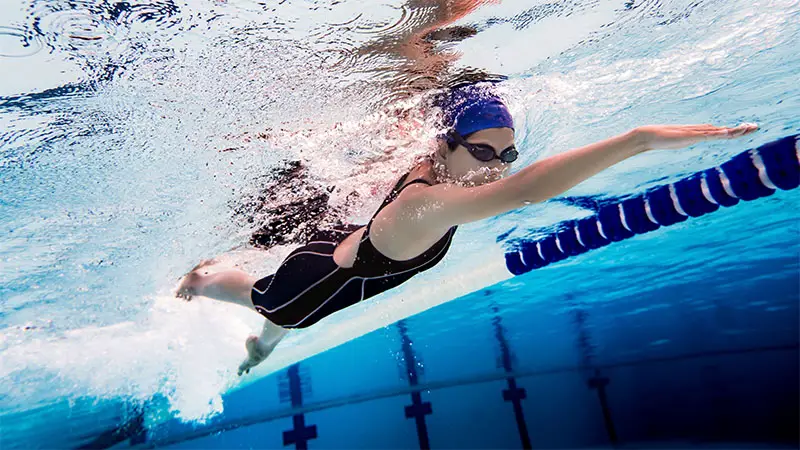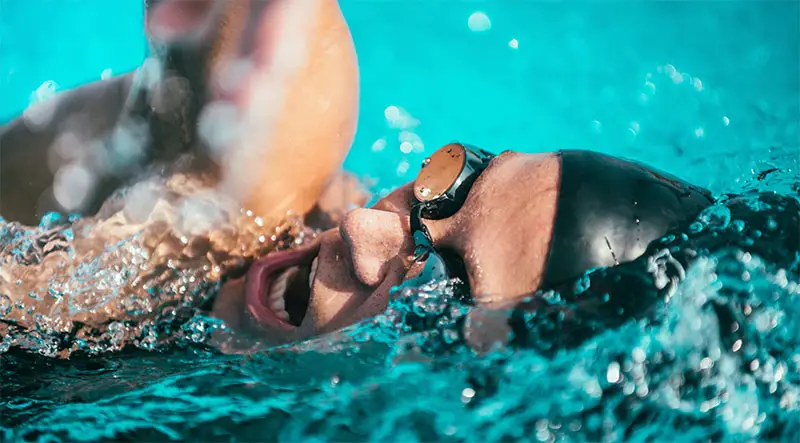When swimming freestyle, you might find it hard to breathe and scary to try. Swimming as a sport requires you to train your body and be able to breathe at all times. When you are swimming, you will move your body to the side, freestyle, and even go through drills where your face is spending most of the time submerged. Swimming is a skill that is great for your body for fitness goals, sports, or even because you simply enjoy it. Continue reading for the proper ways to breathe when swimming freestyle.
Contents
How To Breathe When Swimming Freestyle For Beginners
One of the first things you need to learn when learning how to swim is how to breathe while you are swimming. Breathing techniques change as you advance from beginning swimming to more advanced levels. In order to swim competitively or swim for long distances, you have to deprive your body of oxygen for some period. When a few opportunities arise during strokes for you to breathe, you have to know when that is and how to do that properly so that you can continue swimming.
Basic Breathing When Swimming Freestyle

There are several tips and tricks that you must keep in mind when you are learning how to breathe when swimming freestyle.
- Exhale fully
- Breathe every three strokes
- Keep your head level
When you are breathing and swimming, you need to make sure that you exhale fully, getting out all the carbon dioxide before you inhale oxygen back into your body. Not exhaling fully means that you cannot store as much oxygen, and need to breathe sooner. When swimming freestyle, you exhale underwater so you can inhale as you turn your head to the side.
Some swimmers prefer to breathe after 1 stroke, some prefer after 3-5 strokes. Find what works and feels best for you. For this article, we suggest taking a breath after every third stroke. When you are just starting out, breathing sooner will allow you to put less stress on your lungs and on your body.
When inhaling while swimming freestyle, turn your head to the side, keeping it level with the water. Only one eye and your mouth should be out of the water. When you are rotating strokes and inhaling, a slight tilt is often enough to keep your head level and out of the water.
How To Breathe On Your Side
When you are learning how to breathe when swimming, you will spend a lot of your time breathing on your side. This is something that comes up when you are going through quick freestyle strokes. You probably have a dominant side you prefer, but with breathing, you need to learn to use both sides so that you can breathe successfully.
Bilateral Breathing
One of the best techniques you can use while swimming freestyle is to do bilateral breathing. Bilateral breathing means you take breaths on both right and left sides in between strokes.
For example, after three strokes, rotate your hips and upper body, then inhale on your right side. After three more strokes, rotate your hips and upper body, then inhale on your left side. Do this while exhaling into the water during the three strokes.
Bilateral breathing offers symmetry in your strokes and encourages your swimming to stay on a steady path, all while giving your body the chance to breathe more often. If you only breathe when you turn to your right or your left, then your strokes will curve.
When Do I Breathe?

All swimmers are different. Some prefer breathing after two strokes, while advanced swimmers might prefer after 3 or more strokes. We suggest taking a breath after every 3 strokes.
Staying streamlined in the water is important. Keep your body streamlined by not breathing too often. If you are breathing after every stroke, you will rotate your body too often and break up the streamline, causing drag.
There are certain times you need to know how to breathe as you approach the other side of the pool and when you do a flip turn.
Approaching for a Flip Turn
As you approach the backstroke flags, take a breath while swimming freestyle.
As you approach the wall, take a deep breath 1-2 strokes before you begin the flip turn. You will need to practice this to get your timing right.
This last deep breath will help you get through the flip and back to the surface of the water. If you breathe immediately before you slip, you won’t have enough momentum to complete the flip turn.
Pushing off the Wall
Push off the wall underwater trying to keep a perfect streamline as you can.
Once you come to the surface, take 3 strokes while keeping your head down.
Try your best not to breathe until you reach the backstroke flags. This may take some practice, as the backstroke flags are usually 15 feet from the wall.
You will lose all your momentum if you take a breath right after pushing off the wall.
How To Breathe When Swimming Drills

When you are swimming drills and focusing on getting your strokes and form right, you need to know how to breathe. It can be difficult to breathe while swimming because it does not come naturally, especially if you have never done it before. Your body will naturally want to bring your head above the water and you have to fight that temptation, training your body to breathe differently. Below are different tricks to breathing during swimming drills.
Underwater Breathing Exercise
Before you start this underwater breathing exercise, you need to be completely comfortable exhaling and do not show signs of panic. This is a great breathing drill for beginning swimmers who are looking to go further and advance their craft and skills.
- Start by standing and then slowly bending your knees under your chin to reach the top of the water.
- Inhale a large breath, filling your lungs with as much air as you can.
- Slowly slide down into the water until the line is above your nose bridge and below your goggles.
- Slowly release the air in your lungs by exhaling slowly through your nose. You do not want any air left in your lungs.
- Lift your head out of the water until it is touching your chin and repeat the exercise.
Breathing While Kicking
One of the best ways to improve your breathing is to do so with breathing while kicking drills. There are several steps, but in the end, after many sets, you will have stabilized your breathing. You will need a kickboard for this exercise.
- Hold your kickboard and swim with your face just beneath the water, facing the board. While swimming, start counting your kicks to six with a slow exhalation, emptying your lungs.
- After you have gone through your six kicks, slowly lift your head to either side and get a large inhale of air, filling your lungs completely.
- Lower your face back into the water and exhale slowly over the next six kicks.
This is critical for your body to learn and get your muscle memory in the habit of the six kicks. Repeat this drill until you can do the six kicks without thinking and get your breathing stabilized.
6 Kicks 1 Stroke Drill
When you practice this 6 kicks 1 stroke drill, you are forcing your body to rotate within the water. This makes breathing easier and much more efficient while you are swimming, maximizing how much oxygen you are using in your breaths. Some people may need to use fins for this drill. Do the below steps:
- Turn your body on one side and lift the arm on the opposite side above your head.
- Kick six times before you rotate your body. During these kicks, slowly exhale.
- Before you turn and stroke, make sure you take a deep breath and inhale as much oxygen as you can. You want to fill your lungs and, with practice, you will do so.
- Once you turn, rotate your body to the other side and repeat the kick process six times, and then stroke. Repeat this process, making sure you are breathing during the strokes and exhaling slowly.
Full Freestyle Stroke
The full freestyle stroke breathing exercise is ideal for those who want to learn how to breathe when swimming freestyle. You want to get your breathing under rhythm, where you go at least three strokes before you take another breath and repeat the drill.
- Before you get started, make sure that you take a full breath and begin with your face beneath the water. Once you start with the first stroke, start exhaling until you have completely emptied your lungs and have met your third stroke. It should take three strokes to empty your lungs.
- After the third stroke, make a quick turn with your head and inhale as much oxygen as you can into your lungs before turning your head back into the water.
- Repeat this process with three strokes, and completely let all the air out of your lungs when you exhale beneath the water.
No matter which of these drills you try or use for your breathing habits, you want to keep it up and keep practicing until you feel comfortable. When it becomes natural to breathe under these circumstances and you are no longer focusing so much on getting air, you know that you have achieved these drills.
Wrap-Up
Knowing how to breathe when swimming freestyle doesn’t come naturally. In fact, it is a very unnatural thing for a beginner! That is why it helps to have someone show you the needed tips and steps that will help you learn. Be sure to take your time and be patient. Practice the above how to breathe when swimming drills, and with time, you won’t even think about breathing while swimming freestyle!
